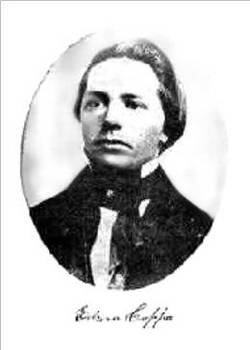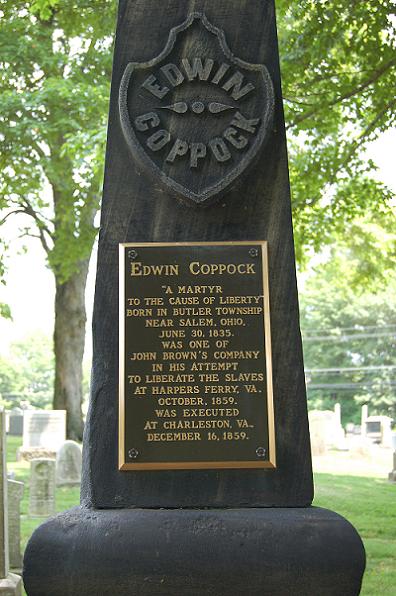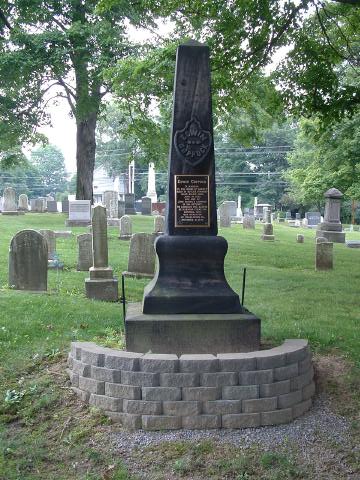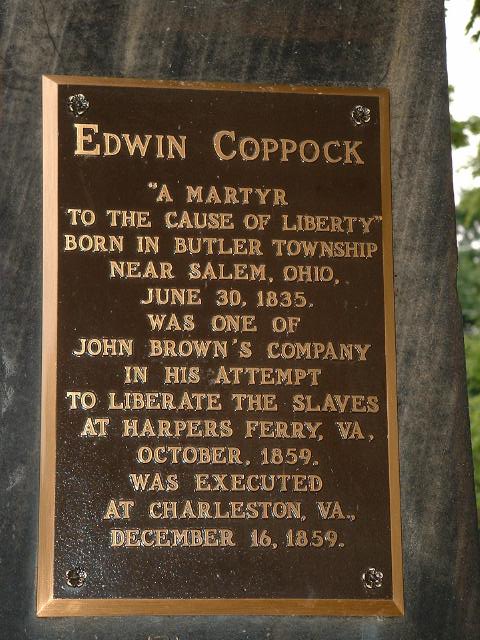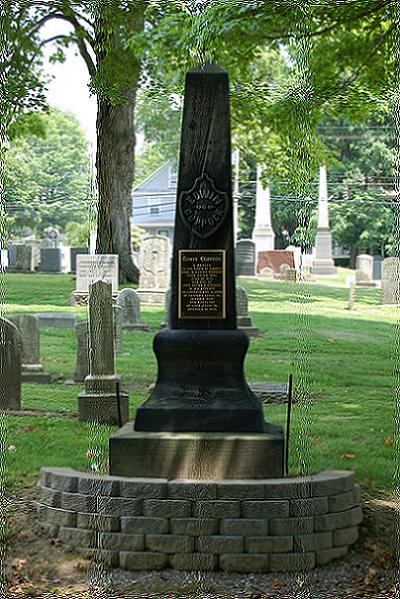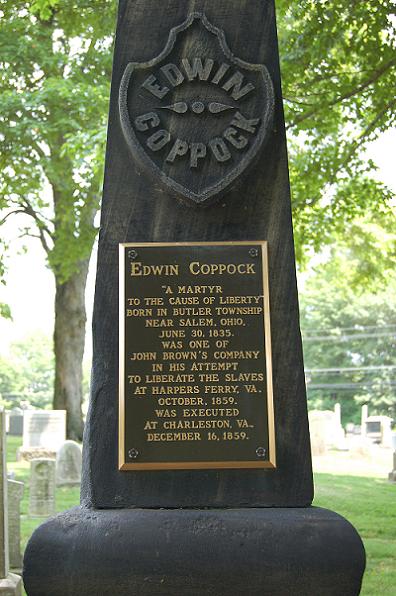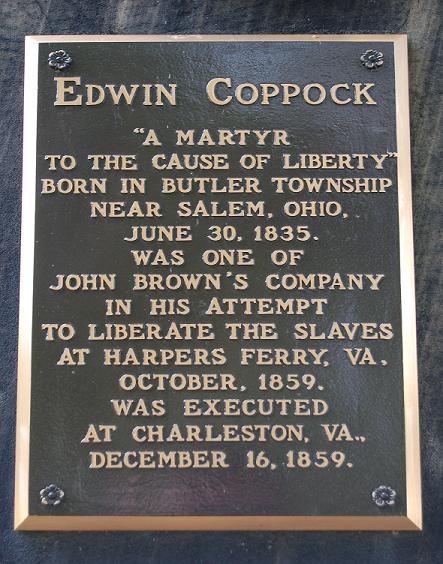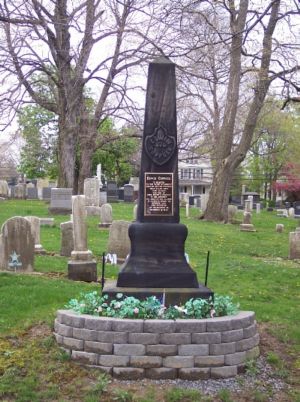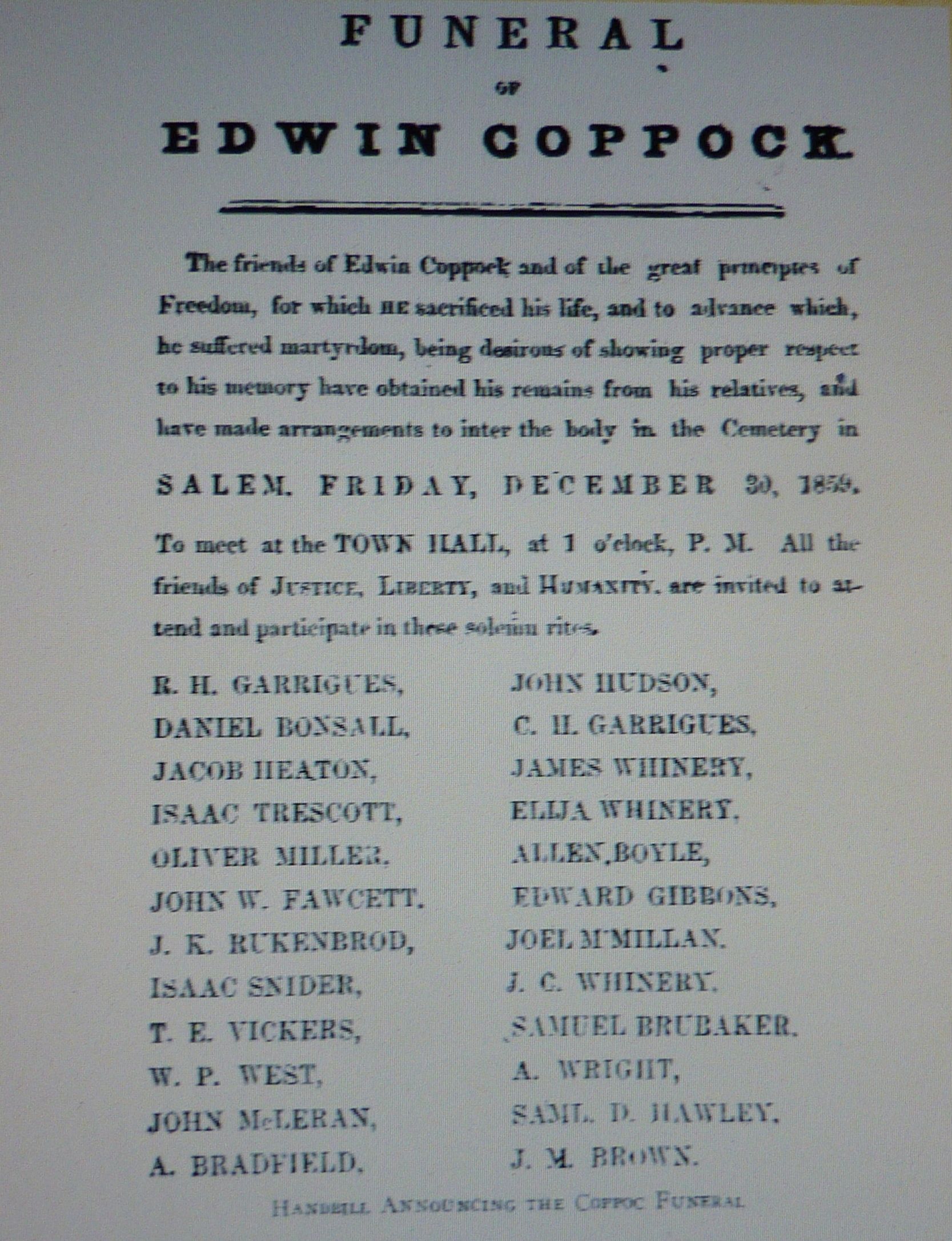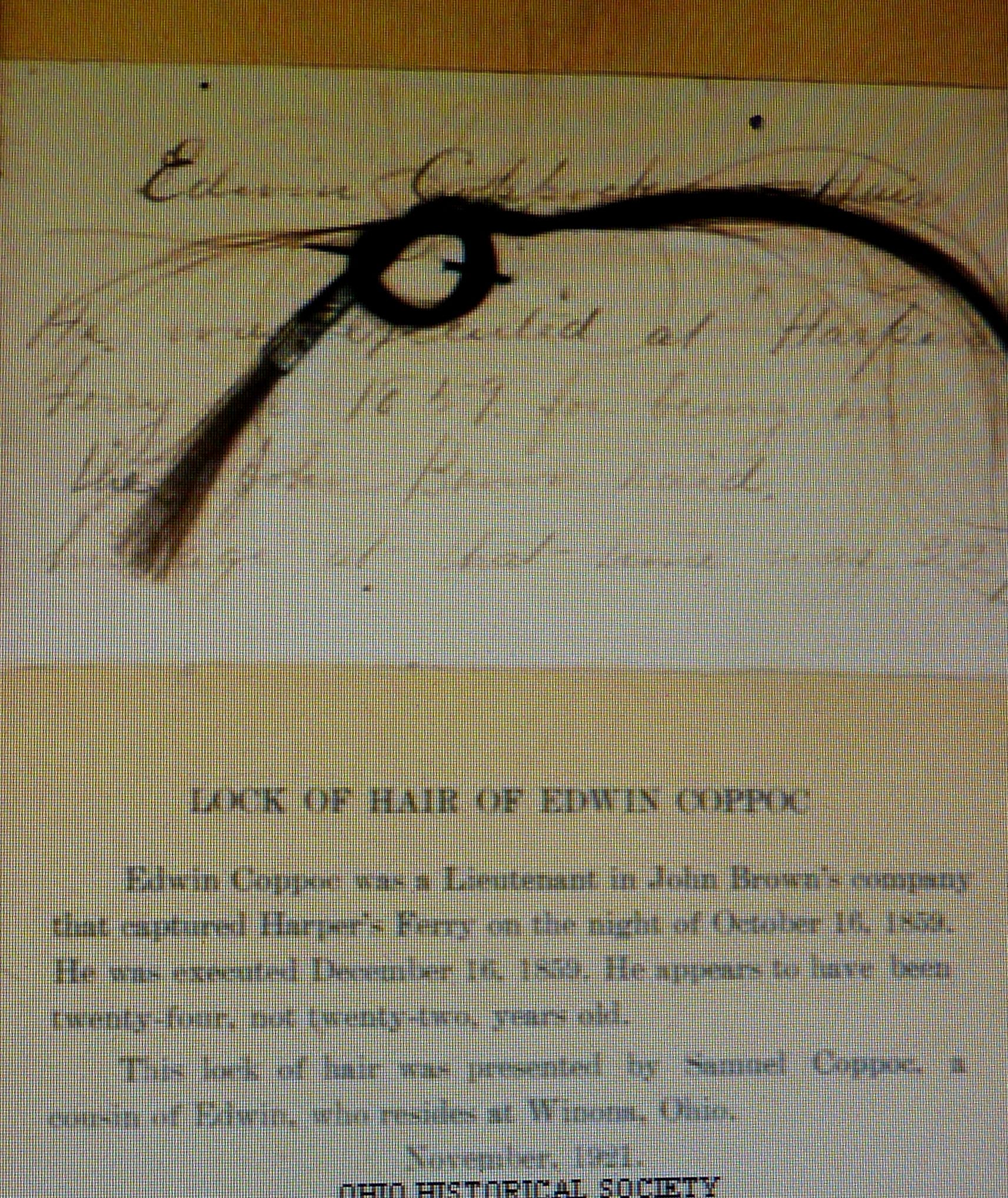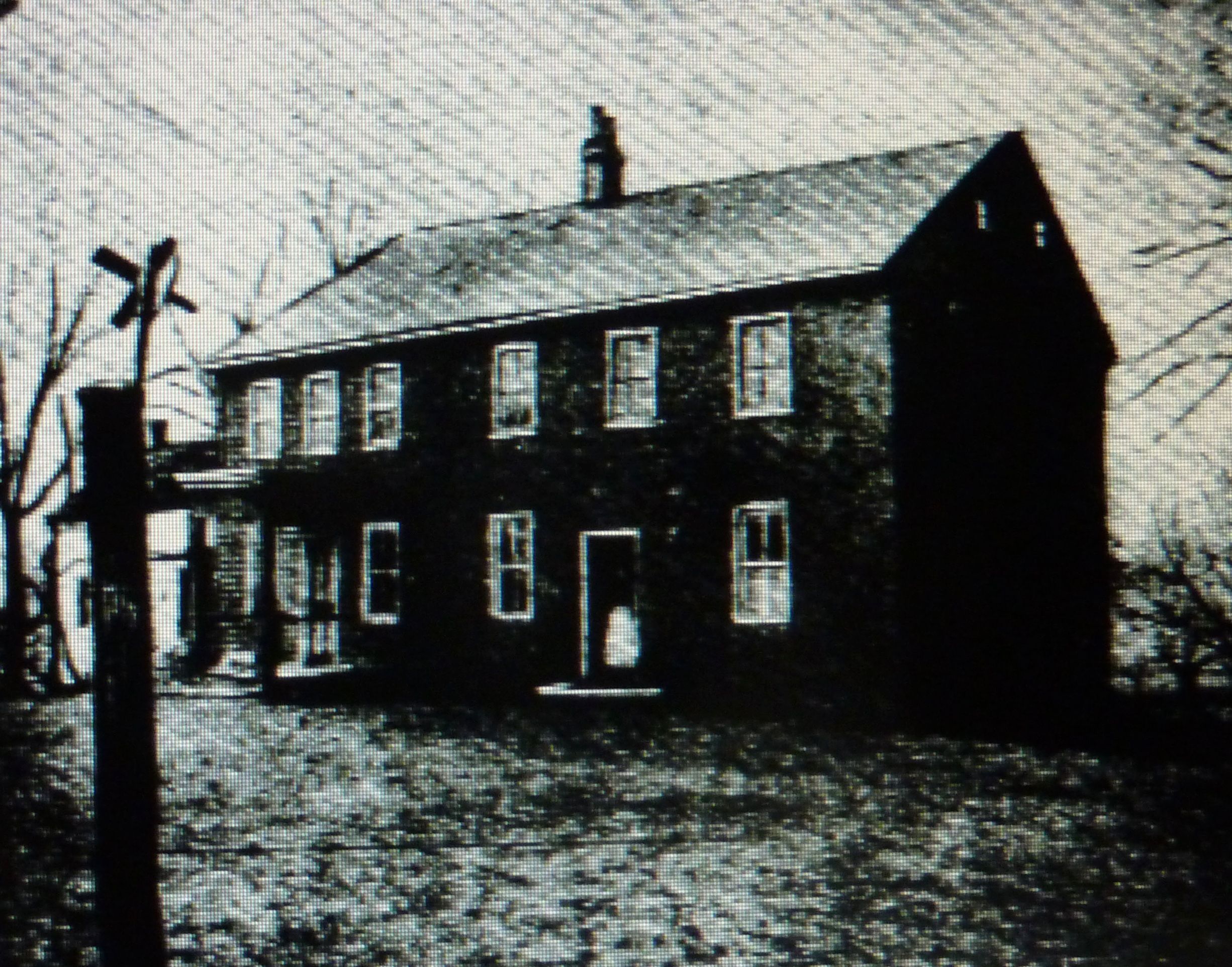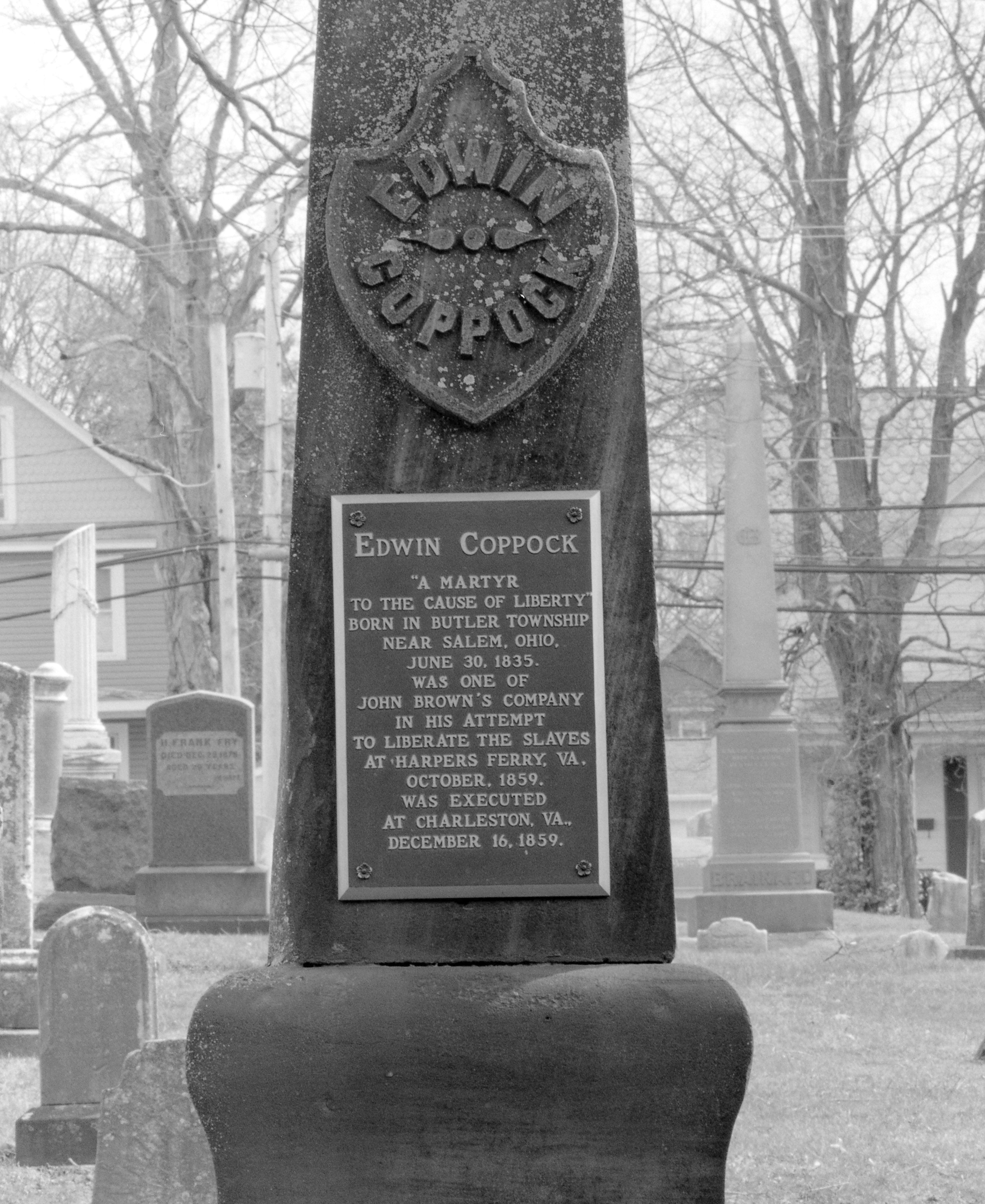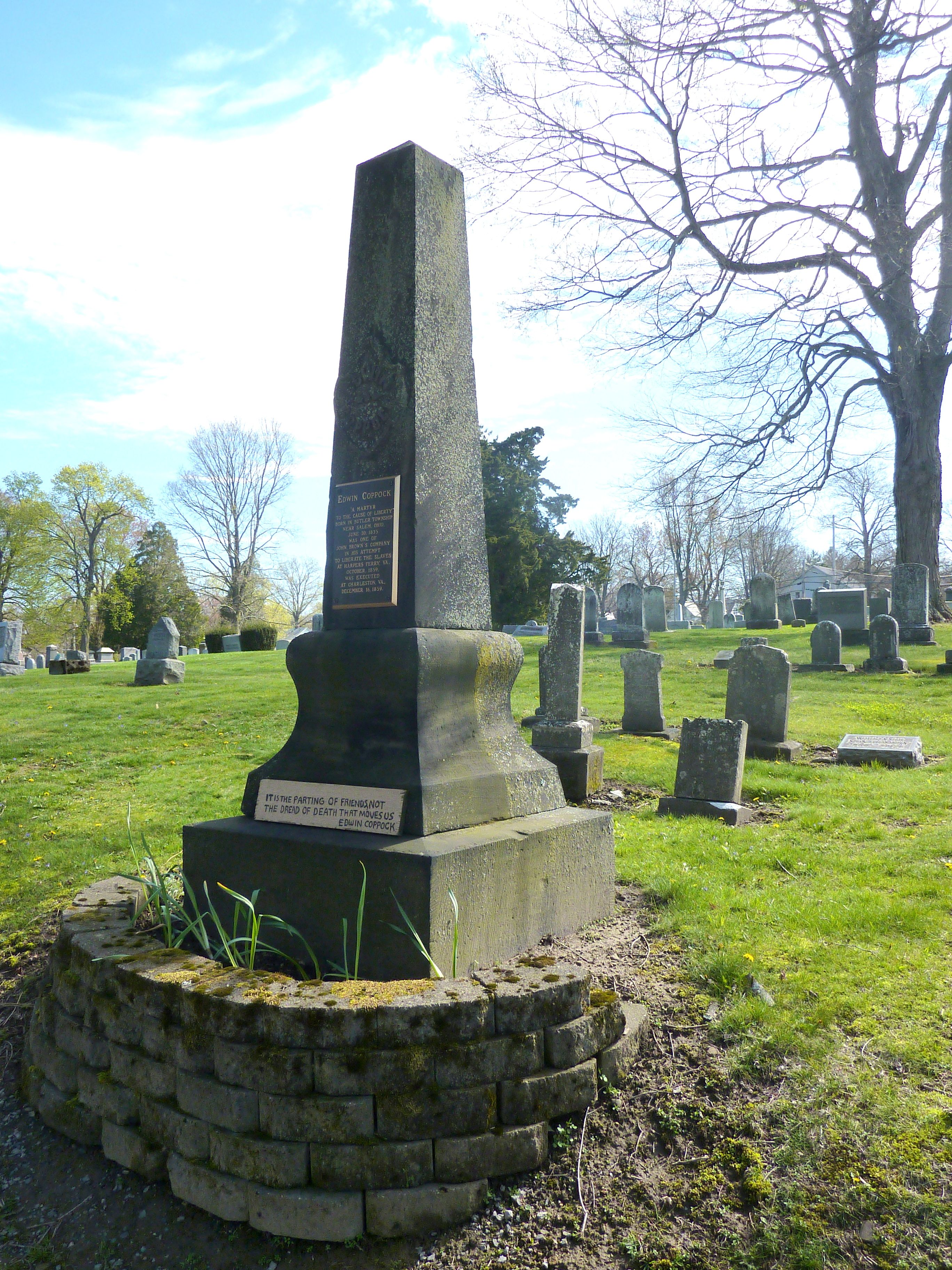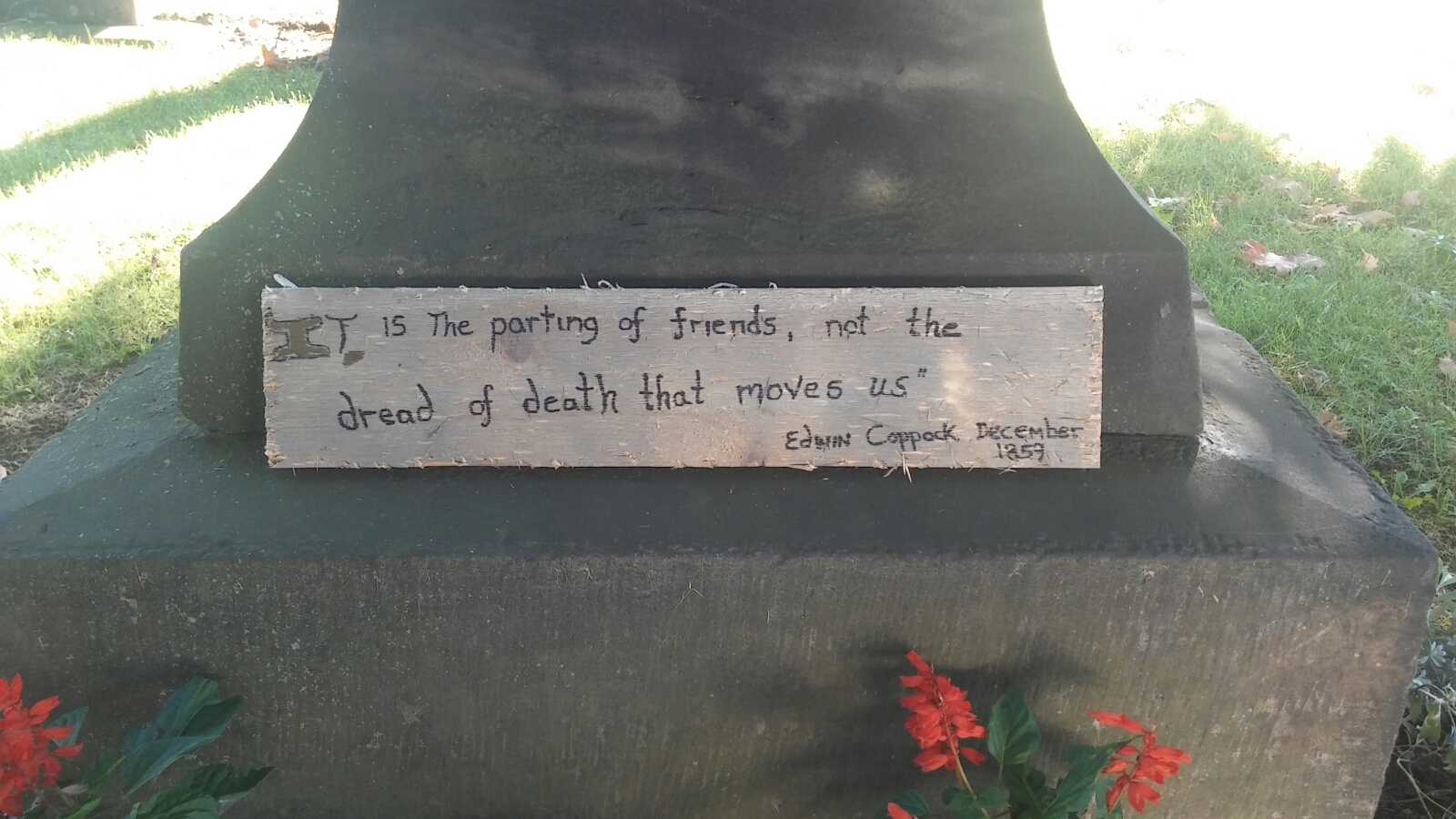~~~~~~~~~~
Edwin Coppoc, the third child of Samuel and Anne (Lynch) Coppock, was born in Butler Township, Columbiana County, Ohio, June 30, 1835. His brother Barclay was born at the same place January 4, 1839. Their father died when the boys were young. They grew up under the influence of a devout mother, grandparents and other relatives. The father died early in 1842, leaving a wife and six children, ranging in ages from one to ten years. In the spring of 1842, a few months after the death of his father, Edwin was placed with John Butler, a farmer of sterling character with whom he remained for eight years. During this time he attended school in the winter and performed the work that usually fell to the lot of farmer boys in the neighborhood.
The years from 1842 to 1850 were eventful. They covered not only the brief period of the Mexican war but the anti-slavery agitation which had been intensified by the results of that war, including a substantial extension of slave territory, and the exciting debates in Congress leading up to the enactment of the Fugitive Slave Law. It is needless to say that discussion of the burning question of the hour was carried on almost without interruption in the Quaker communities of Ohio and much that was said sank deep in the receptive minds of the young. The talk in front of the ample fireplace, at the table, in the church and on the rostrum turned upon the wrongs of those in bonds and the aggressions of the slave power. To all this Edwin Coppoc was an attentive and serious listener. His impressions were lasting; what he heard had much to do with what he became when he reached young manhood's estate.
At the age of fifteen years, somewhat to the regret of Mr. Butler, young Coppoc went to Springdale, Iowa, in what was then known as the far West, to join his mother who had married a man by the name of Raley and was re-establishing a home for her children. She was a woman of native intelligence and strong convictions. Already she had known the trials and vicissitudes of life. She had lost the sight of one eye when she was a child and the other was beginning to fail. Two daugh ters and a son were soon to follow their father to the grave. As Edwin grew into sturdy young manhood she looked to him as a source of comfort and support. He was industrious, frugal and bade fair to become a successful farmer in the new western home. In 1859, Thomas Winn of Springdale, Iowa, wrote of him.
Late in December, 1857, an event of unusual importance occurred in the village of Springdale. It was the arrival of John Brown and his party on their way from Kansas to Canada preparatory to the attack on Harper's Ferry. It had not been the intention of John Brown to stop long at Springdale. He had expected to press on to Ashtabula County, Ohio, as soon as he could sell his teams and wagons and thus realize sufficient money to proceed on the journey by rail. Times were very hard, however, and he could not raise sufficient money to proceed. While cash was scarce, food in this Iowa village was abundant and he found that it would be much cheaper to winter there than to continue eastward.
Besides he found the people of this community in hearty accord with his anti-slavery views. Springdale was settled by the Quakers, a number of them from Ohio. An Iowa writer thus describes the early settlers:
Among the first residents were John H. Painter, a Quaker, who came in 1849; and Anne Coppoc, a Quakeress, and Dr. H. C. Gill who came in 1850.
Brown's men found a pleasing diversion in organizing and successfully conducting a literary or debating society. Tuesday and Friday evenings of each week were set aside for this purpose. A mock legislature was organized which included not only their own number but interested young men in the community who wished to take part. Irving B. Richman thus describes the work of this moot body:
The sessions were held either in the large sitting room of the Maxsons, or in the larger room of the district school building, a mile and a half away. There were a speaker, a clerk of the House, and regular standing committees. Bills were introduced, referred, reported back. debated with intense earnestness and no little ability, and finally brought to a vote. Kagi was the keenest debater and Raelf and Cook orators of very considerable powers.
It is scarcely necessary to state that from the day of the arrival of these guests, Edwin and Barclay Coppoc were sympathetic observers and listeners. "They both took much interest in Brown, his men and his cause, and at length enlisted under his leadership."
If these two boys and the good people of Springdale were favorably impressed with John Brown and his men in the winter of 1857-58 and shed tears when they took their departure on April 27 of the latter year, it will be readily understood that great interest was aroused by the arrival, on February 25, 1859, of John Brown and a part of his faithful band with the eleven negroes whom he had liberated in his famous foray into Missouri.
Many of the Quakers of Springdale heaved an audible sigh of relief when Brown and the negroes departed, but they followed him with ardent prayers for the success of his enterprise and the hope that he might reach Canada in safety and permanently liberate the fugitives without "the snapping of a gun" or the shedding of a drop of blood. It need not be added that there was sincere rejoicing when the news finally came that the long journey of Brown was successfully accomplished. Among those to whom this news was especially gratifying were the Coppoc brothers, who had already enlisted in the great adventure, the details of which were rapidly taking shape in the secretive mind of their visionary and indomitable leader.
At last on Sunday night, October 16, nineteen men fully armed marched from the Kennedy Farm. Edwin Coppoc was among the number. Barclay remained behind with Merriam and Owen Brown to guard arms and stores.
Onward in silence under the shades of night the resolute little band marched into Harper's Ferry. In accordance with previous plans, carefully laid, Albert Hazlett and Edwin Coppoc took charge of the United States armory as soon as the guards there were overpowered and made prisoners. Long before dawn of the next day Harper's Ferry, the United States arsenal, the rifle works, the engine house and the approaches to the town were in the hands of the invaders. As the startled inhabitants awoke they realized that they were captives in the hands of an unknown military force. The story of the fighting that followed on those memorable days, October 17 and 18, between Brown and his followers and the Virginia militia and the United States marines under the command of Lieutenant Colonel Robert E. Lee, now in a uniform of blue but later in a uniform of gray and commander-in-chief of the Confederate army, has been told often in graphic detail and need not here be dwelt upon at length. On the day following the attack Edwin Coppoc was driven under fire from the armory into the engine house where John Brown made his last stand, fighting the infuriated Virginians and the marines as they battered in the doors behind which he and the remnant of his followers were beaten down and captured. Strange to say, Edwin was not even wounded.
Jesse W. Graham, a workman in the United States armory and a captive of John Brown, related this interesting incident of the siege of the engine house, after the arrival of the marines under Lieutenant Colonel Robert E. Lee:
Early on Tuesday morning I peeped out of a hole and saw Colonel Lee, whom I had seen before at the Ferry, standing close by with the troops behind him. A negro stood near him, holding a large military cloak. Just then Edwin Coppoc thrust me aside, and thrust the muzzle of his gun into the hole, drawing a bead on Lee. I interposed, putting my hand on the rifle and begging the man not to shoot, as that was Colonel Lee, of the United States army, and if he were hurt the building would be torn down and they'd all be killed. Green again put up his pistol and Coppoc readjusted his rifle. During this momentary altercation, Robert E. Lee had stepped aside, and thus his life was saved to the slaveholder's Confederacy.
Shortly after the capture of the engine house, S. K. Donovan, the first newspaper correspondent on the ground after the raid commenced, impressed with the apparent youth of Edwin Coppoc, his bearing and frank face that seemed out of harmony with the tragic experiences of the last two days and nights went up to him and said:
"My God, boy, what are you doing at a place like this?" "'With remarkable coolness' said Donovan 'the boy answered, as I recall the words, I believe in the principles that we are trying to advance and I have no apologies for being here. I think it is a good place to be.'
On the morning of December 16 the prisoners were aroused early and prepared for execution. The ministers and a few others besides the officers were permitted to meet them before they left the jail.
"It is hard to die," remarked a Quaker to Coppoc.
"It is the parting of friends, not the dread of death that moves us," was the reply.
The two men were remarkably cheerful before leaving but seated on their coffins their expressions changed. One correspondent wrote:
The countenance of Coppoc changed; his face wore a settled expression of despair. He looked wildly around upon the crowd, and his large eyes lighted with an unnatural luster. Many a heart sighed for him. Most of the community were anxious for a commutation of his sentence.
Like John Brown, this youth in his last hours was sustained by the faith that the cause was worthy of the sacrifice. But he was young and the current of health coursing through his veins made life precious and its surrender sad.
Arriving at the scaffold, "the calm and collected manner of both was very marked." "They both exhibited the most unflinching firmness, saying nothing, with the exception of bidding farewell to the ministers and sheriff." "After the cap had been placed on their heads, Coppoc turned toward Cook and stretched forth his hand as far as possible. At the same time Cook said, 'Stop a minute -where is Edwin's hand?' They then shook hands cordially and Cook said, 'God bless you'."
After everything was in readiness, Cook said "Be quick -as quick as possible," which was echoed by Coppoc, and in a few moments they departed this life forever.
After receiving a letter from his nephew, Joshua Coppoc had gone at once to Charlestown. The day before the execution he talked over with Edwin and Thomas Winn matters of mutual interest and the former changed the request, expressed in his letter, to a preference for burial near his birthplace in Columbiana County.
This is only part of what C. B. Galbreath. wrote
Flinsbach
Contributor: Flinsbach (49222948)
~~~~~~~~~~
Edwin Coppoc, the third child of Samuel and Anne (Lynch) Coppock, was born in Butler Township, Columbiana County, Ohio, June 30, 1835. His brother Barclay was born at the same place January 4, 1839. Their father died when the boys were young. They grew up under the influence of a devout mother, grandparents and other relatives. The father died early in 1842, leaving a wife and six children, ranging in ages from one to ten years. In the spring of 1842, a few months after the death of his father, Edwin was placed with John Butler, a farmer of sterling character with whom he remained for eight years. During this time he attended school in the winter and performed the work that usually fell to the lot of farmer boys in the neighborhood.
The years from 1842 to 1850 were eventful. They covered not only the brief period of the Mexican war but the anti-slavery agitation which had been intensified by the results of that war, including a substantial extension of slave territory, and the exciting debates in Congress leading up to the enactment of the Fugitive Slave Law. It is needless to say that discussion of the burning question of the hour was carried on almost without interruption in the Quaker communities of Ohio and much that was said sank deep in the receptive minds of the young. The talk in front of the ample fireplace, at the table, in the church and on the rostrum turned upon the wrongs of those in bonds and the aggressions of the slave power. To all this Edwin Coppoc was an attentive and serious listener. His impressions were lasting; what he heard had much to do with what he became when he reached young manhood's estate.
At the age of fifteen years, somewhat to the regret of Mr. Butler, young Coppoc went to Springdale, Iowa, in what was then known as the far West, to join his mother who had married a man by the name of Raley and was re-establishing a home for her children. She was a woman of native intelligence and strong convictions. Already she had known the trials and vicissitudes of life. She had lost the sight of one eye when she was a child and the other was beginning to fail. Two daugh ters and a son were soon to follow their father to the grave. As Edwin grew into sturdy young manhood she looked to him as a source of comfort and support. He was industrious, frugal and bade fair to become a successful farmer in the new western home. In 1859, Thomas Winn of Springdale, Iowa, wrote of him.
Late in December, 1857, an event of unusual importance occurred in the village of Springdale. It was the arrival of John Brown and his party on their way from Kansas to Canada preparatory to the attack on Harper's Ferry. It had not been the intention of John Brown to stop long at Springdale. He had expected to press on to Ashtabula County, Ohio, as soon as he could sell his teams and wagons and thus realize sufficient money to proceed on the journey by rail. Times were very hard, however, and he could not raise sufficient money to proceed. While cash was scarce, food in this Iowa village was abundant and he found that it would be much cheaper to winter there than to continue eastward.
Besides he found the people of this community in hearty accord with his anti-slavery views. Springdale was settled by the Quakers, a number of them from Ohio. An Iowa writer thus describes the early settlers:
Among the first residents were John H. Painter, a Quaker, who came in 1849; and Anne Coppoc, a Quakeress, and Dr. H. C. Gill who came in 1850.
Brown's men found a pleasing diversion in organizing and successfully conducting a literary or debating society. Tuesday and Friday evenings of each week were set aside for this purpose. A mock legislature was organized which included not only their own number but interested young men in the community who wished to take part. Irving B. Richman thus describes the work of this moot body:
The sessions were held either in the large sitting room of the Maxsons, or in the larger room of the district school building, a mile and a half away. There were a speaker, a clerk of the House, and regular standing committees. Bills were introduced, referred, reported back. debated with intense earnestness and no little ability, and finally brought to a vote. Kagi was the keenest debater and Raelf and Cook orators of very considerable powers.
It is scarcely necessary to state that from the day of the arrival of these guests, Edwin and Barclay Coppoc were sympathetic observers and listeners. "They both took much interest in Brown, his men and his cause, and at length enlisted under his leadership."
If these two boys and the good people of Springdale were favorably impressed with John Brown and his men in the winter of 1857-58 and shed tears when they took their departure on April 27 of the latter year, it will be readily understood that great interest was aroused by the arrival, on February 25, 1859, of John Brown and a part of his faithful band with the eleven negroes whom he had liberated in his famous foray into Missouri.
Many of the Quakers of Springdale heaved an audible sigh of relief when Brown and the negroes departed, but they followed him with ardent prayers for the success of his enterprise and the hope that he might reach Canada in safety and permanently liberate the fugitives without "the snapping of a gun" or the shedding of a drop of blood. It need not be added that there was sincere rejoicing when the news finally came that the long journey of Brown was successfully accomplished. Among those to whom this news was especially gratifying were the Coppoc brothers, who had already enlisted in the great adventure, the details of which were rapidly taking shape in the secretive mind of their visionary and indomitable leader.
At last on Sunday night, October 16, nineteen men fully armed marched from the Kennedy Farm. Edwin Coppoc was among the number. Barclay remained behind with Merriam and Owen Brown to guard arms and stores.
Onward in silence under the shades of night the resolute little band marched into Harper's Ferry. In accordance with previous plans, carefully laid, Albert Hazlett and Edwin Coppoc took charge of the United States armory as soon as the guards there were overpowered and made prisoners. Long before dawn of the next day Harper's Ferry, the United States arsenal, the rifle works, the engine house and the approaches to the town were in the hands of the invaders. As the startled inhabitants awoke they realized that they were captives in the hands of an unknown military force. The story of the fighting that followed on those memorable days, October 17 and 18, between Brown and his followers and the Virginia militia and the United States marines under the command of Lieutenant Colonel Robert E. Lee, now in a uniform of blue but later in a uniform of gray and commander-in-chief of the Confederate army, has been told often in graphic detail and need not here be dwelt upon at length. On the day following the attack Edwin Coppoc was driven under fire from the armory into the engine house where John Brown made his last stand, fighting the infuriated Virginians and the marines as they battered in the doors behind which he and the remnant of his followers were beaten down and captured. Strange to say, Edwin was not even wounded.
Jesse W. Graham, a workman in the United States armory and a captive of John Brown, related this interesting incident of the siege of the engine house, after the arrival of the marines under Lieutenant Colonel Robert E. Lee:
Early on Tuesday morning I peeped out of a hole and saw Colonel Lee, whom I had seen before at the Ferry, standing close by with the troops behind him. A negro stood near him, holding a large military cloak. Just then Edwin Coppoc thrust me aside, and thrust the muzzle of his gun into the hole, drawing a bead on Lee. I interposed, putting my hand on the rifle and begging the man not to shoot, as that was Colonel Lee, of the United States army, and if he were hurt the building would be torn down and they'd all be killed. Green again put up his pistol and Coppoc readjusted his rifle. During this momentary altercation, Robert E. Lee had stepped aside, and thus his life was saved to the slaveholder's Confederacy.
Shortly after the capture of the engine house, S. K. Donovan, the first newspaper correspondent on the ground after the raid commenced, impressed with the apparent youth of Edwin Coppoc, his bearing and frank face that seemed out of harmony with the tragic experiences of the last two days and nights went up to him and said:
"My God, boy, what are you doing at a place like this?" "'With remarkable coolness' said Donovan 'the boy answered, as I recall the words, I believe in the principles that we are trying to advance and I have no apologies for being here. I think it is a good place to be.'
On the morning of December 16 the prisoners were aroused early and prepared for execution. The ministers and a few others besides the officers were permitted to meet them before they left the jail.
"It is hard to die," remarked a Quaker to Coppoc.
"It is the parting of friends, not the dread of death that moves us," was the reply.
The two men were remarkably cheerful before leaving but seated on their coffins their expressions changed. One correspondent wrote:
The countenance of Coppoc changed; his face wore a settled expression of despair. He looked wildly around upon the crowd, and his large eyes lighted with an unnatural luster. Many a heart sighed for him. Most of the community were anxious for a commutation of his sentence.
Like John Brown, this youth in his last hours was sustained by the faith that the cause was worthy of the sacrifice. But he was young and the current of health coursing through his veins made life precious and its surrender sad.
Arriving at the scaffold, "the calm and collected manner of both was very marked." "They both exhibited the most unflinching firmness, saying nothing, with the exception of bidding farewell to the ministers and sheriff." "After the cap had been placed on their heads, Coppoc turned toward Cook and stretched forth his hand as far as possible. At the same time Cook said, 'Stop a minute -where is Edwin's hand?' They then shook hands cordially and Cook said, 'God bless you'."
After everything was in readiness, Cook said "Be quick -as quick as possible," which was echoed by Coppoc, and in a few moments they departed this life forever.
After receiving a letter from his nephew, Joshua Coppoc had gone at once to Charlestown. The day before the execution he talked over with Edwin and Thomas Winn matters of mutual interest and the former changed the request, expressed in his letter, to a preference for burial near his birthplace in Columbiana County.
This is only part of what C. B. Galbreath. wrote
Flinsbach
Contributor: Flinsbach (49222948)
Bio by: Rich H.
